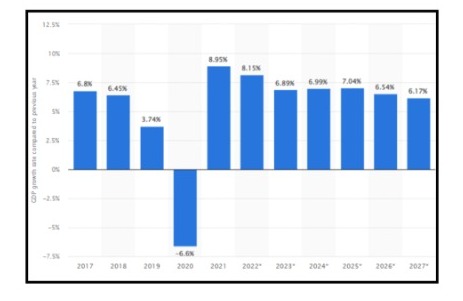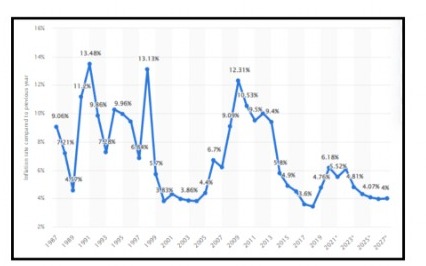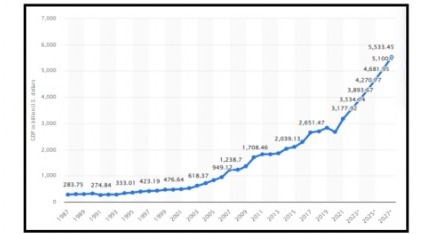GLOBAL BUSINESS IN CONTEXT ASSIGNMENT SAMPLE
1. Introduction
1.1 Company overview
CafePod Coffee Co. is one of the SME in the UK and established in the year 2011. The business was founded by “Peter Grainger and Brent Hadfield” and focuses on “the production of coffee”. The company has a turnover of “£ 3.5 million” and focuses on “bringing happiness” to the lives of coffee drinkers (cafepod.com, 2022). The company has acted as an “independent craft” in the coffee business. The company has focused on “bringing adventures” to the coffee drinkers “so they can enjoy the quality coffee at their homes”.
They have blended delicacies with “Brunch Blend, Intense roast, Supercharger Espresso, SW18 Daily Grind and Decaf Espresso”. The company owners have also focused on the UK supermarkets of Retail coffee as well as the “energy of the High street coffee shops” while setting up the business. The business organizations offer their products in all the “key supermarkets as well as the online retailers” they stress the wide range of “Nespresso Comparative Aluminum pods, Roast Whole Bean and Ground Coffee”.
1.2 Justification of expansion decision
The company focuses on expanding the business to the country of India by analyzing the FDI available. Establish a strong brand name and focus on the stagnant coffee market in the UK. The retail sector along with the coffee industry of India has grown. The business organization has targeted the number of growing coffee consumers.
2. Analysis of the environmental factors and impact on the internalization process
2.1 Factor 1: Economic sustainability through GDP, tax rate and FDI
India has become one of the largest democracies in the world and has enjoyed a stable political environment. The government of India has stressed privatization, which helps business organizations to grow independently.
According to the views of Bretos et al. (2020), for market expansion, a country has several rules and laws that influence the growth of the industry. The country supports “foreign direct investment, service tax, and income tax”. In addition to that, it has several tax policies that directly affect the “capital market of the country”.

Figure 1: Real gross domestic product (GDP) growth rate from 2017 to 2027
(Source: statista.com, 2022)
In the year 2021, the GDP of the country turned into 8.95%. It is going to continue to grow over the years. With the emerging opportunities in the market of India, the company might face rivalries while expanding in the Indian Market. The coffee industry has gained immense opportunities in the current market of the country.
Rivalry acts as a strong factor in the coffee industry as the number of coffee manufacturing companies has bloomed (Ashraf et al. 2020). The company might face strong competition from “Nescafe, Seven Beans co, Starbucks, Blue Tokai, the Indian bean” and others. India has different varieties of “coffee is grown” and the region includes “Anamalais, Wayanad”. In addition to that, the country has become famous for “Arabica and Robusta coffee”.
As opined by Ledesma-Chaves et al. (2020), the factors that influence the market expansion depend on the capital market or large-scale labour availability. India has a complex “labour and land law”. As India’s GDP has become relatively low in comparison to that of the “low and the middle-income countries”.
The country needs to focus on rationalizing direct tax “for both corporate and personal tax” that will help international companies on foreign direct investment. It aims to attract “private investment” so that they can contribute to the “exchequer” (Paul and Jadhav, 2019). The Cofeepod co. can focus on directly investing in the facilities available in the country as it helps them in focusing on the “capital to cover their costs”.
The current political scenario of the country India stresses that companies having “large cash reserves” affects the business organizations in terms of international expansion.
These help in enabling a higher public investment. The country has released “Strategy for New India @75” by the NITI Aayog, which will focus on achieving the UN Sustainable Development Goals and accelerating their “economic growth”. The government aims to make the economy a “$4 – trillion economy” by the year 2022-2023 and that will affect the companies.
The “lowering of the government’s Debt ratio” helps in reducing the “high-interest cost burden”. The Indian government has stressed the budget so that it can “improve the availability of credit” for the private companies mostly in the financial market.
As India has focused on the road to development, the company faces threats from new entrants as well. Hiring people that include consultants, employees or property managers becomes easy in the country. The domestic market of the country, therefore, provides different opportunities to both the local and the international companies.
2.2 Factor 2: Inflation rate and legal implications
The company needs to focus on the profitability of the business and devise short and long-term goals accordingly. India has “strong macroeconomic fundamentals” that focus on the “low and stable rate of inflation”.

Figure 2: Inflation rate from 1987 to 2027
(Source: statista.com, 2022)
Besides GDP, the company needs to focus on the inflation rate for expanding into the market of India. From the graphical representation, the inflation rate from the year 2019 to 2021 has gone through a significant change and “projections up until 2027”. The inflation rate depends upon several factors that include “federal fees as well as the taxes”. In the year 2021, the inflation rate became 5.52% and for the year 2022, it became 6.08%.
The country has a significant “eco money growth” as per the Industrial Reform Policies in the year 1991; the country provides opportunities to international companies. According to the views of Gulanowski et al. (2018), business organizations need to focus on the social factors and technological factors for market expansion. India provides cheap labour that helps the business organization while operating in the internal market and focus on easing the “labour and land regulation” by implementing “Fixed Term Employment”. Fair and uniform labour laws help in “easing industrial relations” as well as “social security” helps in the “formalization of the labour force”.
India has looked forward to enhancing the skills of its workforce through the “Labour Market Information system (LMIS)”. India provides various opportunities to women employees and the Maternity Benefit (Amendment Act) of 2017 implemented throughout the country. The country also has the Sexual Harassment of Women at work Place (Prevention, prohibition and Redressal) Act that will help the company to gain female labourers. India has focused on increasing its “technical capabilities” through its “Export Promotion council (EPCs)”.
The country has focused on developing diplomatic relations with various countries. The country has developed close relations with the BIMSTEC frameworks so that export and import with both the developing and emerging economies can become possible.
The country aims to improve its “cross-border movements of goods and services” by integration helps in the promotion of goods and services. This aims to attract “private investment” so that it can contribute on becoming the “exchequer” (Hayat, 2019).
They can get information about the labour market and hiring will become easier through the LMIS system. Besides cheap labour, the skill-training program will helps the business organisation to train their employees according to the market needs. The sustainable production of goods and services will help the business organisation despite market competition.
2.3 Factor 3: Innovation through technological advancement and foreign trading
India has become one of the countries that have progressed in terms of technological advancement. In recent years, the country has focused on improving itself and reaching the top countries in the “Global Innovation index 2022-2023”. In the year, the rate of India among 132 countries became 46 based on their “innovation inputs and outputs”.
Technological advancement has improved the “production, distribution as well as the communication”. This will provide immense opportunities to the company. In addition to that, different technological companies have also focused on investing in the country that ensures “constant software up-gradation and advancement” (Ko, 2019). The company need to focus on the country’s economic growth for technological advancement.

Figure 3: Gross domestic product in current prices from 1987 to 2021
(Source: statista.com, 2022)
The GDP in terms of the current prices for the year 2021 became 5100 dollars, which will help the company to focus on “demand and supply”. According to the views of Tocar (2018), in addition to that, the country stressed considering the current environmental crisis and considering eco-friendly products. The country has focused on “foreign trade so that they can provide opportunities to the foreign brands”.
The country has improved itself in terms of “automation, innovation, technological awareness” that has influenced various business operations. The technological advancement has improved in terms of “production, distribution or communication” that helps the internal business organisations in terms of oversees expansion.
The company need to focus on the country’s economic growth for technological advancement and formulate expansion strategy accordingly. The company need to consider the various factors of the foreign direct investment such as “establish a new venture” or joint venture” in order to enter into the market of India. The market of the company will gain business advantages by “concentrating the customers”.
3. Entry mode Evaluation
Business organizations focus on entering the foreign market so that they can increase their sales and benefits, and gain brand recognition. According to the views of Rundh (2022), the business organization focuses on “reducing the risk of operating in one market”.
The company already operating in the market of London has focused on extending its services to foreign economies. There are several market entry methods available in the business market to expand a company’s organizational process [Refer to Appendix]. In the case of the market entry methods, exporting refers to the “direct goods or services” in another nation.
The company if it undertakes such a method of operating in a foreign market can stress the low risks. This slot becomes a “cost-effective method” of entering the foreign market. Foreign direct investment (FDI) helps in “directly investing in facilities” in the international market. Companies needs to consider factors such as “establish a new venture, acquiring an existing company” if it focuses on entering into the market through FDI.
The company will have to focus on the “capital to cover costs” in terms of premises, employees and staff”. According to the views of Paul and Feliciano-Cestero (2021) in case of the direct exporting, every company need to start by setting up the company from “scratch”.
The country’s political climate helps in attracting foreign direct investment. Therefore, it takes affordable time to consider market research, hiring and scoping representatives from the desired country. Foreign direct investment has certain advantages and most companies prefer such strategies to expand in the market.
The business organizations can focus on the “concessions from the local governments” to make investments and gain business advantages. The changing patterns of the market in India have stressed most coffee production focus on the market of India despite a large number of tea drinkers.
The consumers might not “initially get drawn” therefore the company needs to “focus on the niche market in India”. In India, coffee evaluation has helped the retailers to focus on the country. The government has also focused on providing “ 100 %” FDI to the coffee plantation.
The company needs to focus on a “memorandum of understanding (MoU) with other leading brands in the country” so that they can move forward in business. Cofeepod can become the “ownership of intellectual property”. However, the success gained by the international company Starbucks shows that setting up coffee production can become beneficial for the company. For coffee production or setting up coffee shops, export and import become crucial factors. The company can get the raw materials easily due to improved diplomatic ties with other coffee-producing nations.
4. Recommendations
The company needs to focus on the method of foreign direct investment while entering the overseas market. According to the views of Solarin and Al-Mulali (2018), foreign direct investment strategy includes “mergers and acquisitions, joint ventures and greenfield investments”.
The business organization needs to focus on “repeat purchase and loyalty” besides engaging in “the advertising and traditional marketing” it needs to focus on improving the “in-store experiences as well”. They need to focus on examining the business “focusing on the distributors” by focusing on both the “lighter roast as well as the traditional dark offering”. In addition to that, the business organization needs to consider opening their stores at “high traffic locations” in the cities.
As a small business organization, they need to consider expanding into the market with “joint ventures” with other coffee production companies. As the retail market of the country has opened various opportunities, the business organization needs to focus on collaborating with Indian supermarkets as well as retail stores. As referred to by Cannizzaro and Weiner (2018), business organizations need to focus on the “runaway inflation, currency devaluation and improved standards of living”. While expanding into the market of India, they need to consider focusing “on the domestic partners” so that they can establish “ a marketing infrastructure”. Joint ventures with the “local retailers” help in understanding the “aims and objectives of the brand”.
A joint venture helps in “research and development” that in turn helps in “creating a new product” (Xin-gang et al. 2019). The business organization can focus on the growth of the business as it provides “opportunities to combine and collaborator the resources”. They can gain business advantages by “saving money”.
5. Conclusion
The present study deals with the market entry of the business organization. The company has taken the strategy to expand into the teen market of India so that they can establish a strong brand name and gain business. The company has focused on strategically analysing the external factors before entering the market of the selected country.
The company intends to utilize the market opportunities through foreign direct investment and generate business profits. Joint ventures helps in “focusing on the divisions of profits and losses” in a case of dissatisfaction, the company can leave or terminate the agreement. The legal framework provides help in the “dispute resolution process”. The company has focused to utilize the cheap labour opportunities, skills and market opportunities provided by the government to focus on the overseas market and gain business advantages.
6. Reference list
cafepod.com, 2022. Profile. Available at: https://www.cafepod.com/pages/our-story [Accessed on: 25.07.2022]
Ashraf, A., Doytch, N. and Uctum, M., 2020. Foreign direct investment and the environment: disentangling the impact of greenfield investment and merger and acquisition sales. Sustainability Accounting, Management and Policy Journal.
Bretos, I., Díaz-Foncea, M. and Marcuello, C., 2020. International expansion of social enterprises as a catalyst for scaling up social impact across borders. Sustainability, 12(8), p.3262.
Cannizzaro, A.P. and Weiner, R.J., 2018. State ownership and transparency in foreign direct investment. Journal of International Business Studies, 49(2), pp.172-195.
globalinnovationindex.org, 2022. Home. Available at: https://www.globalinnovationindex.org/Home [Accessed on: 22.07.2022]
Gulanowski, D., Papadopoulos, N. and Plante, L., 2018. The role of knowledge in international expansion: Toward an integration of competing models of internationalization. Review of International Business and Strategy.
Hayat, A., 2019. Foreign direct investments, institutional quality, and economic growth. The Journal of International Trade & Economic Development, 28(5), pp.561-579.
Ko, S.J., 2019. The Differing Foreign Entry Mode Choices for Sales and Production Subsidiaries of Multinational Corporations in the Manufacturing Industry. Sustainability, 11(15), p.4089.
Ledesma-Chaves, P., Arenas-Gaitán, J. and Garcia-Cruz, R., 2020. International expansion: mediation of dynamic capabilities. Marketing Intelligence & Planning.
Paul, J. and Feliciano-Cestero, M.M., 2021. Five decades of research on foreign direct investment by MNEs: An overview and research agenda. Journal of business research, 124, pp.800-812.
Paul, J. and Jadhav, P., 2019. Institutional determinants of foreign direct investment inflows: evidence from emerging markets. International Journal of Emerging Markets.
Rundh, B., 2022. International expansion or stagnation: market development for mature products. Asia-Pacific Journal of Business Administration, (ahead-of-print).
Solarin, S.A. and Al-Mulali, U., 2018. Influence of foreign direct investment on indicators of environmental degradation. Environmental Science and Pollution Research, 25(25), pp.24845-24859.
statista.com. 2022. Construction industry in India – statistics & facts. Available at: https://www.statista.com/topics/7869/construction-industry-in-india/ [Accessed on: 22.07.2022]
statista.com. 2022. GDP in India. Available at: https://www.statista.com/statistics/263771/gross-domestic-product-gdp-in-india/ [Accessed on: 22.07.2022]
statista.com. 2022. India: Inflation rate from 1987 to 2027. Available at: https://www.statista.com/statistics/271322/inflation-rate-in-india/ [Accessed on: 22.07.2022]
statista.com. 2022. India: Real gross domestic product (GDP) growth rate from 2017 to 2027. Available at: https://www.statista.com/statistics/263617/gross-domestic-product-gdp-growth-rate-in-india/ [Accessed on: 22.07.2022]
Tocar, S., 2018. Determinants of foreign direct investment: A review. Review of Economic and Business Studies, 11(1), pp.165-196.
Xin-gang, Z., Yuan-feng, Z. and Yan-bin, L., 2019. The spillovers of foreign direct investment and the convergence of energy intensity. Journal of cleaner production, 206, pp.611-621.
24/7 Chat Support | Get A+ Grade | Written by Top-Notch Subject Experts | 20% Off 1st Order |
Know more about UniqueSubmission’s other writing services:


Thank you for your sharing. I am worried that I lack creative ideas. It is your article that makes me full of hope. Thank you. But, I have a question, can you help me?